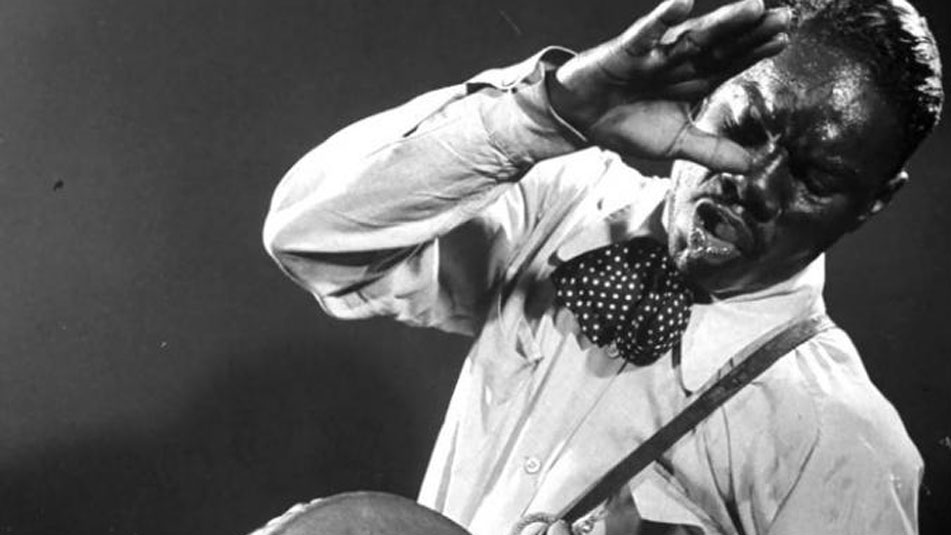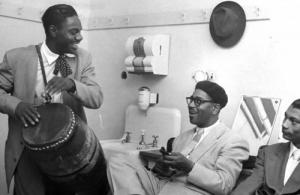CHANO POZO
LEGACY OF THE ULTIMATE RUMBERO
January 20, 2016 | by y Rebeca Mauleón

Few percussionists have played as integral a role in shaping Latin music as Luciano “Chano” Pozo González (1915-1948). Born in former slave quarters in Havana, Pozo ascended as one of Cuba’s most influential percussionists of the early 20th century, transcending race and socioeconomic status while playing key roles in a wide range of folkloric and popular genres, both in his native Cuba and, upon emigrating in 1946, in the United States. Conga player, composer, dancer, and Bon Vivant, Pozo cut his teeth as a teenager in Havana’s seedy clubs and bars, often accepting paltry sums as a bouncer to support his family while making his way as a rumbero (rumba dancer/performer) and street fighter, before being taken more seriously as an award-winning choreographer. His groove-laden compositions made their way into Havana’s cabaret scene (including the famed Tropicana) and on to New York City, where groundbreaking brothers-in-law Mario Bauzá and Frank Grillo “Machito” transformed Pozo’s rhythmically intricate pieces into an entirely new and harmonically rich sound that we would later call “Latin jazz.”
 Hearing of the popularity of his songs in New York, Pozo journeyed north and immediately found himself among the cultural elite, working alongside a who’s who of musicians and dancers, among them Miguelito Valdés (aka Mr Babalú) and Katherine Dunham, before a fateful introduction would change his life - and the musical landscape - dramatically. On the advice of Mario Bauzá, trumpeter and band leader Dizzy Gillespie sought out the Cuban conga sensation in the hopes Chano would join his newly formed big band. The resulting collaboration would produce a treasure trove of now-classic compositions that embody both jazz and Latin jazz standard repertoire, notably the 1947 composition “Manteca.” While the seeds of Latin jazz had already been planted with the Machito Orchestra (under the musical direction of Bauzá), Chano Pozo’s legacy as both an instrumentalist and composer would mark the sanctified marriage of Cuban music and jazz for all eternity. Between 1947 and his death in 1948, Chano co-created numerous compositions alongside Gillespie that would affirm and legitimize a truly “new” music, including "Tintin Deo," "Guachi Guaro" (famously covered by Cal Tjader), "Blen Blen Blen" and many others.
Hearing of the popularity of his songs in New York, Pozo journeyed north and immediately found himself among the cultural elite, working alongside a who’s who of musicians and dancers, among them Miguelito Valdés (aka Mr Babalú) and Katherine Dunham, before a fateful introduction would change his life - and the musical landscape - dramatically. On the advice of Mario Bauzá, trumpeter and band leader Dizzy Gillespie sought out the Cuban conga sensation in the hopes Chano would join his newly formed big band. The resulting collaboration would produce a treasure trove of now-classic compositions that embody both jazz and Latin jazz standard repertoire, notably the 1947 composition “Manteca.” While the seeds of Latin jazz had already been planted with the Machito Orchestra (under the musical direction of Bauzá), Chano Pozo’s legacy as both an instrumentalist and composer would mark the sanctified marriage of Cuban music and jazz for all eternity. Between 1947 and his death in 1948, Chano co-created numerous compositions alongside Gillespie that would affirm and legitimize a truly “new” music, including "Tintin Deo," "Guachi Guaro" (famously covered by Cal Tjader), "Blen Blen Blen" and many others.
As Dizzy fondly recounted, Chano had the power to mesmerize the audience as he stripped to the waist performing long conga solos and singing sacred Afro-Cuban chants. Jazz audiences went nuts for this musical mixture, witnessing a jazz band infused by Afro-Cuban folk idioms and showcasing the indelible African link between these musical cousins. With all of Chano’s celebrity, however, his generational “error” was being born too soon; his hopes of fleeing the racism of pre-revolutionary Cuba found little consolation as he experienced the segregation of the southern United States while touring with Dizzy’s band. Outside of Harlem, there was scarcely any safe haven for Afro Cuban musicians, who found more obstacle than opportunity. Prone to a less than exemplary lifestyle, Chano’s dalliance with illegal drugs - while not uncommon among most jazz musicians of the time - resulted in a tragic end when coupled by his hot temper. It was a dispute with a drug dealer that lead to Chano’s demise on a New York barroom floor, when Chano, accusing the dealer of selling him cheap marijuana, publically insulted him before being shot dead. Not two years into his search for fame and fortune, Luciano “Chano” Pozo’s life came to an end, but his musical legacy remains in the hands of countless generations of Latin jazz musicians.
